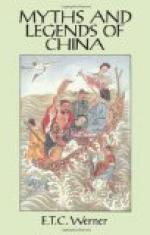Taking into consideration all the existing evidence, the objections to all other theories of the origin of the Chinese seem to be greater than any yet raised to the theory that immigrants from the Tarim valley or beyond (i.e. from Elam or Akkadia, either direct or via Eastern Turkestan) struck the banks of the Yellow River in their eastward journey and followed its course until they reached the localities where we first find them settled, namely, in the region covered by parts of the three modern provinces of Shansi, Shensi, and Honan where their frontiers join. They were then (about 2500 or 3000 B.C.) in a relatively advanced state of civilization. The country east and south of this district was inhabited by aboriginal tribes, with whom the Chinese fought, as they did with the wild animals and the dense vegetation, but with whom they also commingled and intermarried, and among whom they planted colonies as centres from which to spread their civilization.
The K’un-lun Mountains
With reference to the K’un-lun Mountains, designated in Chinese mythology as the abode of the gods—the ancestors of the Chinese race—it should be noted that these are identified not with the range dividing Tibet from Chinese Turkestan, but with the Hindu Kush. That brings us somewhat nearer to Babylon, and the apparent convergence of the two theories, the Central Asian and the Western Asian, would seem to point to a possible solution of the problem. Nue Kua, one of the alleged creators of human beings, and Nue and Kua, the first two human beings (according to a variation of the legend), are placed in the K’un-lun Mountains. That looks hopeful. Unfortunately, the K’un-lun legend is proved to be of Taoist origin. K’un-lun is the central mountain of the world, and 3000 miles in height. There is the fountain of immortality, and thence flow the four great rivers of the world. In other words, it is the Sumeru of Hindu mythology transplanted into Chinese legend, and for our present purpose without historical value.
It would take up too much space to go into details of this interesting problem of the origin of the Chinese and their civilization, the cultural connexions or similarities of China and Western Asia in pre-Babylonian times, the origin of the two distinct culture-areas so marked throughout the greater part of Chinese history, etc., and it will be sufficient for our present purpose to state the conclusion to which the evidence points.




